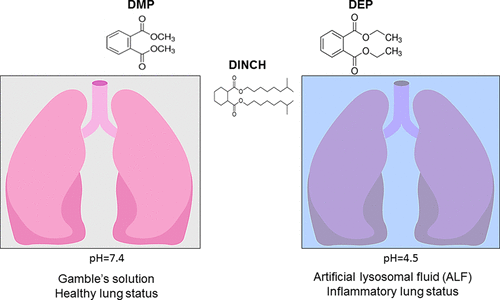当前位置:
X-MOL 学术
›
Environ. Sci. Technol. Lett.
›
论文详情
Our official English website, www.x-mol.net, welcomes your
feedback! (Note: you will need to create a separate account there.)
In Vitro Inhalation Bioaccessibility of Phthalate Esters and Alternative Plasticizers Present in Indoor Dust Using Artificial Lung Fluids
Environmental Science & Technology Letters ( IF 8.9 ) Pub Date : 2018-04-24 , DOI: 10.1021/acs.estlett.8b00113 Katerina Kademoglou 1, 2 , Georgios Giovanoulis 3 , Anna Palm-Cousins 3 , Juan Antonio Padilla-Sanchez 4 , Jörgen Magnér 3 , Cynthia A. de Wit 5 , Christopher D. Collins 1
Environmental Science & Technology Letters ( IF 8.9 ) Pub Date : 2018-04-24 , DOI: 10.1021/acs.estlett.8b00113 Katerina Kademoglou 1, 2 , Georgios Giovanoulis 3 , Anna Palm-Cousins 3 , Juan Antonio Padilla-Sanchez 4 , Jörgen Magnér 3 , Cynthia A. de Wit 5 , Christopher D. Collins 1
Affiliation

|
Phthalate esters (PEs) are used as plasticizers in consumer products. Their low migration stability has resulted in the classification of PEs as major indoor contaminants. Because of PE’s ubiquity and adverse health effects on humans and especially children, non-phthalate alternative plasticizers have been introduced into the market. This is the first study of in vitro inhalation bioaccessibility of PEs (e.g., DMP, DEP, and DEHP) and alternative plasticizers (e.g., DEHT and DINCH) via indoor dust to assess inhalation as an alternative route of exposure. Two artificial lung fluids were used, mimicking two distinctively different pulmonary environments: (1) artificial lysosomal fluid (ALF, pH 4.5) representing the intracellular acidic lung fluid inhaled particle contact after phagocytosis by alveolar macrophages and (2) Gamble’s solution (pH 7.4), the extracellular healthy fluid for deep lung deposition of dust. DMP and DEP were highly bioaccessible (>75%), whereas highly hydrophobic compounds such as DEHP, DINCH, and DEHT were <5% bioaccessible via both artificial lung fluids. Our findings show that the inhalation bioaccessibility of PEs is primarily governed by their hydrophobicity and water solubility. Further research is necessary to develop unified and biologically relevant inhalation bioaccessibility tests, employed as part of human risk assessment of volatile and semivolatile organic pollutants.
中文翻译:

使用人工肺部液体的室内粉尘中邻苯二甲酸酯和替代增塑剂的体外吸入生物可及性
邻苯二甲酸酯(PEs)在消费产品中用作增塑剂。它们的低迁移稳定性导致将PE归类为主要的室内污染物。由于PE普遍存在且对人类尤其是儿童有害健康,因此非邻苯二甲酸酯类替代增塑剂已投放市场。这是体外的第一个研究PE(例如DMP,DEP和DEHP)和替代增塑剂(例如DEHT和DINCH)通过室内粉尘的吸入生物可及性,以评估吸入作为暴露的另一种途径。使用了两种人造肺液,模仿了两种截然不同的肺部环境:(1)代表肺泡巨噬细胞吞噬吞噬后细胞内酸性肺液吸入颗粒接触的人造溶酶体液(ALF,pH 4.5)和(2)Gamble's solution(pH 7.4) ,是深层肺部灰尘沉积的细胞外健康液。DMP和DEP具有很高的生物可及性(> 75%),而高度疏水的化合物(如DEHP,DINCH和DEHT)通过两种人工肺液的生物可及性小于5%。我们的发现表明,PE的吸入生物可及性主要受其疏水性和水溶性的支配。
更新日期:2018-04-24
中文翻译:

使用人工肺部液体的室内粉尘中邻苯二甲酸酯和替代增塑剂的体外吸入生物可及性
邻苯二甲酸酯(PEs)在消费产品中用作增塑剂。它们的低迁移稳定性导致将PE归类为主要的室内污染物。由于PE普遍存在且对人类尤其是儿童有害健康,因此非邻苯二甲酸酯类替代增塑剂已投放市场。这是体外的第一个研究PE(例如DMP,DEP和DEHP)和替代增塑剂(例如DEHT和DINCH)通过室内粉尘的吸入生物可及性,以评估吸入作为暴露的另一种途径。使用了两种人造肺液,模仿了两种截然不同的肺部环境:(1)代表肺泡巨噬细胞吞噬吞噬后细胞内酸性肺液吸入颗粒接触的人造溶酶体液(ALF,pH 4.5)和(2)Gamble's solution(pH 7.4) ,是深层肺部灰尘沉积的细胞外健康液。DMP和DEP具有很高的生物可及性(> 75%),而高度疏水的化合物(如DEHP,DINCH和DEHT)通过两种人工肺液的生物可及性小于5%。我们的发现表明,PE的吸入生物可及性主要受其疏水性和水溶性的支配。











































 京公网安备 11010802027423号
京公网安备 11010802027423号